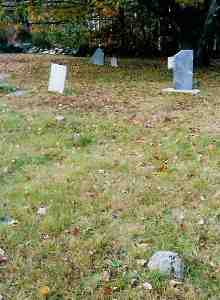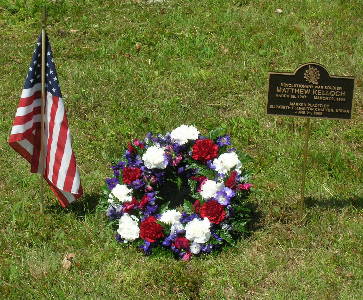Matthew Kelloch
Written by Marilyn Morrison for D.A.R. Grave Dedication
Matthew Kelloch was born March 29, 1737, the son of Scotch-Irish
immigrant parents Finley and Mary (Young) Kelloch. The Finley Kellochs
were 1735 pioneer settlers of St. George’s, Maine.
The Kelloch homestead
was in what is now the town of Warren. Maine was then part of the
Massachusetts Bay Colony.
Finley Kelloch served with colonial New England forces during King
George’s
War and took part in the 1745 capture and garrisoning of the great
French
fortress at Louisbourg, Cape Breton Island. He and other
settler-soldiers who could not leave their families behind, unprotected
and unprovided for, took them along. Thus eight-year-old Matthew,
encamped with his family outside the fortress walls, was present at the
siege, fall and occupation of Louisbourg.
It was another three years before a peace treaty was signed between
England and France. During this time, French-incited Indian depredations
laid waste the settlement at St. George’s, driving the settlers in to
live at fort and blockhouse. Their log homes, grist and saw mills and
crops in the field were plundered and destroyed and their livestock
killed or driven off. Not until 1749 could the Kellochs and their
neighbors safely leave their garrisoned refuges to rebuild and replant.
The peace did not endure. The Indian threat was never entirely absent
until well after the French defeat at
Quebec in l759. Between 1744 and 1758, at least 26 settlers, soldiers
and others were killed by Indians at
St. George’s. Still others were captured and carried off to Canada.
Even with a military troop presence, it was necessary for the colonists
to assist in their own defense. Colony records from 1755 tell us that in
that year”. . . a company of rangers scouting to the eastward [of St. George’s] was this year kept in pay from June
19th to Nov. 20th. . . “ Entered on the muster roll was the name of 18-year-old Matthew Kelloch,
“Centinnel”. It was a duty to which he was probably accustomed; until at
least 1760, males “able to bear arms” were regularly mustered to serve
in the ranger units.
Matthew Kelloch married Mary Robinson in 1758. Mary was the daughter of
Moses and Mary
(Fitzgerald) Robinson, early pioneer settlers of Cushing, Maine. Matthew
and Mary had ten children:
David, Margaret, Finley III, Moses, Mary, Jane, Catherine, Matthew Jr., Hanse, and Sarah.
Matthew served during the American Revolution as both a foot soldier of
the Massachusetts Line and a sailor, perhaps a marine, in the
Continental Navy. In his pension declaration, he attested: “About the
last of April 1775 I enlisted as a Private under Capt. Samuel Gregg in
the Massachusetts Regiment commanded by Col. James Cargill; I served in
said Gregg’s Company and in the Regiment aforesaid from last of April
until the first day of January 1776; I was then discharged by said Col.
Cargill but not in writing. I further declare that about the middle of
November 1778, I enlisted under Samuel Gregg for the Boston frigate,
commanded by Capt. Samuel Tucker, and entered on board said frigate till
the month of December; that while on board said frigate we took 11 of
the armed vessels belonging to the British, and that I finally left said
frigate December 1779.”
A respected local historian of the 1800s tells us it was recorded that
in 1784, returned from the war, “Matthew Kelloch, during the season of
cherries and blackberries,. . . shot 14 bears, young and old, without
going out of his way.”
As with Daniel Boone, hunting prowess in early eastern Maine put food on
the table but brought no more wealth than in frontier Kentucky. When in
April 1818 Matthew applied for a pension for his war service, his listed
assets were two cows, an ox, one plow and chain, six chairs, one chest
and one pine table, "necessary clothing and bedding excepted.” In
applying, he cited inability to pursue his farming occupation any longer
by reason of old age. The pursuit had been long and well run, however;
when he died six years later, preceded by wife Mary, he was almost 87.
|

